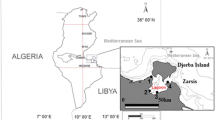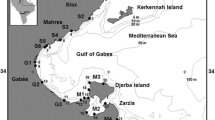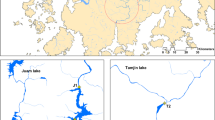Abstract
Nutrient enrichment of aquatic ecosystems caused dramatic increase in the frequency, magnitude and duration of cyanobacterial blooms. Such blooms may cause fish kills, have adverse health effects on humans and contribute to the loss of biodiversity in aquatic ecosystems. Some 50 eutrophic to hypereutrophic ponds from the Brussels Capital Region (Belgium) were studied between 2003 and 2009. A number of the ponds studied are prone to persistent cyanobacterial blooms. Because of the related health concerns and adverse effects on ecological quality of the affected ponds, a tool for assessment of the risk of cyanobacterial bloom occurrence was needed. The data acquired showed that cyanobacteria have threshold relationships with most of the environmental factors that control them. This is negatively reflected on the predictive capacity of conventional statistical methods based on linear relationships. Therefore, classification trees designed for the treatment of complex data and non-linear relationships were used to assess the risk of cyanobacterial bloom occurrence. The main factors determining cyanobacterial bloom development appeared to be phytoplankton biomass, pH and, to a lesser degree, nitrogen availability. These results suggest that to outcompete eukaryotic phytoplankters cyanobacteria need the presence of environmental constraints: carbon limitation, light limitation and nitrogen limitation, for which they developed a number of adaptations. In the absence of constraints, eukaryotic phytoplankters appear to be more competitive. Therefore, prior build up of phytoplankton biomass seems to be essential for cyanobacterial dominance. Classification trees proved to be an efficient tool for the bloom risk assessment and allowed the main factors controlling bloom development to be identified as well as the risk of bloom occurrence corresponding to the conditions determined by these factors to be quantified. The results produced by the classification trees are consistent with those obtained earlier by probabilistic approach to bloom risk assessment. They can facilitate planning management interventions and setting restoration priorities.







Similar content being viewed by others
References
APHA-AWWA-WEF, 1995. Standard methods for the examination of water and wastewater. American Public Health Association, Washington, D.C.
Benndorf, J., W. Boing, J. Koop & I. Neubauer, 2002. Top-down control of phytoplankton: the role of time scale, lake depth and trophic state. Freshwater Biology 47: 2282–2295.
Breiman, L., J. H. Freidman, R. A. Olshen & C. J. Stone, 1984. Classification and Regression Trees. Wadsworth & Brooks, Monterey.
Briand, J.-F., S. Jacquet, C. Bernard & J.-F. Humbert, 2003. Health hazards for terrestrial vertebrates from toxic cyanobacteria in surface water ecosystems. Veterinary Research 34: 1–17.
Brönmark, C. & L.-A. Hansson, 2005. The Biology of Lakes and Ponds. Oxford University Press, Oxford.
Carmichael, W. W., 2001. Human fatalities from cyanobacteria: chemical and biological evidence for cyanotoxins. Environmental Health Perspectives 109: 663–668.
Carpenter, S. R., J. J. Cole, J. R. Hodgson, J. F. Kitchell, M. L. Pace, D. Bade, K. L. Cottingham, T. E. Essington, J. N. Houser & D. E. Schindler, 2001. Trophic cascades, nutrients, and lake productivity: whole-lake experiments. Ecological Monographs 71: 163–186.
De’ath, G. & K. E. Fabricius, 2000. Classification and regression trees: a powerful yet simple technique for ecological data analysis. Ecology 81: 3178–3192.
Dillon, P. J. & F. H. Rigler, 1974. Phosphorus-chlorophyll relationship in lakes. Limnology and Oceanography 19: 767–773.
Dokulil, M. T. & K. Teubner, 2000. Cyanobacterial dominance in lakes. Hydrobiologia 438: 1–12.
Downing, J. A., S. B. Watson & E. McCauley, 2001. Predicting Cyanobacteria dominance in lakes. Canadian Journal of Fisheries & Aquatic Sciences 58: 1905–1908.
Ferber, L. R., S. N. Levine, A. Lini & G. P. Livingston, 2004. Do cyanobacteria dominate in eutrophic lakes because they fix atmospheric nitrogen? Freshwater Biology 49: 690–708.
Gliwicz, Z. M., 1990. Why do cladocerans fail to control algal blooms? Hydrobiologia 200: 83–97.
Graham, L. E. & L. W. Wilcox, 2000. Algae. Prentice-Hall, Upper Saddle River.
Hasle, G. R., 1978. The inverted-microscope method. In Sournia, A. (ed.), Phytoplankton manual. UNESCO, Paris: 88–96.
Hudnell, K. H., 2008. Cyanobacterial Harmful Algal Blooms. Springer, New York.
Hyenstrand, P., P. Nyvall, A. Pettersson & P. Blomqvist, 1998. Regulation of non-nitrogen-fixing cyanobacteria by inorganic nitrogen sources – experiments from Lake Erken. In Forsberg, C. & K. Pettersson (eds), Advances in Limnology 51 – Lake Erken – 50 Years of Limnological Research. E Schweizerbart’sche Verlagsbuchhandlung, Stuttgart pp 29–40.
Hyenstrand, P., U. Burkert, A. Pettersson & P. Blomqvist, 2000. Competition between the green alga Scenedesmus and the cyanobacterium Synechococcus under different modes of inorganic nitrogen supply. Hydrobiologia 435: 91–98.
Irfanullah, H. M. & B. Moss, 2005. A filamentous green algae-dominated temperate shallow lake: variations on the theme of clearwater stable states? Archiv Fur Hydrobiologie 163: 25–47.
Kemp, P. F., B. F. Sherr, E. B. Sherr & J. J. Cole, 1993. Handbook of Methods in Aquatic Microbial Ecology. Lewis Publishers, Boca Raton.
Moss, B., D. Stephen, C. Alvarez, E. Becares, W. Van de Bund, S.E. Collings, E. Van Donk, E. De Eyto, T. Feldmann, C. Fernandez-Alaez, M. Fernandez-Alaez, R. J. M. Franken, F. Garcia-Criado, E. M. Gross, M. Gyllstrom, L. A. Hansson, K. Irvine, A. Jarvalt, J. P. Jensen, E. Jeppesen, T. Kairesalo, R. Kornijow, T. Krause, H. Kunnap, A. Laas, E. Lille, B. Lorens, H. Luup, M. R. Miracle, P. Noges, T. Noges, M. Nykanen, I. Ott, W. Peczula, E. Peeters, G. Phillips, S. Romo, V. Russell, J. Salujoe, M. Scheffer, K. Siewertsen, H. Smal, C. Tesch, H. Timm, L. Tuvikene, I. Tonno, T. Virro, E. Vicente & D. Wilson, 2003. The determination of ecological status in shallow lakes – a tested system (ECOFRAME) for implementation of the European Water Framework Directive. Aquatic Conservation: Marine and Freshwater Ecosystems 13: 507–549.
Paerl, H. W. & J. Huisman, 2008. Climate: blooms like it hot. Science 320: 57–58.
Pavlik-Skowronska, B., J. Pirszel & R. Kornijow, 2008. Spatial and temporal variation in microcystin concentrations during perennial bloom of Planktothrix agardhii in a hypertrophic lake. Annales De Limnologie (International Journal of Limnology) 44: 145–150.
Peretyatko, A., J.-J. Symoens & L. Triest, 2007a. Impact of macrophytes on phytoplankton in eutrophic peri-urban ponds, implications for pond management and restoration. Belgian Journal of Botany 140: 83–99.
Peretyatko, A., S. Teissier, J.-J. Symoens & L. Triest, 2007b. Phytoplankton biomass and environmental factors over a gradient of clear to turbid peri-urban ponds. Aquatic Conservation: Marine and Freshwater Ecosystems 17: 584–601.
Peretyatko, A., S. Teissier, S. De Backer & L. Triest, 2010. Assessment of the risk of cyanobacterial bloom occurrence in urban ponds: probabilistic approach. Annales De Limnologie (International Journal of Limnology) 46: 121–133.
Pflugmacher, S., 2004. Promotion of oxidative stress in the aquatic macrophyte Ceratophyllum demersum during biotransformation of the cyanobacterial toxin microcystin-LR. Aquatic Toxicology 70: 169–178.
Phillips, G., O. P. Pietilainen, L. Carvalho, A. Solimini, A. L. Solheim & A. C. Cardoso, 2008. Chlorophyll-nutrient relationships of different lake types using a large European dataset. Aquatic Ecology 42: 213–226.
Pourriot, R., 1995. Réponses adaptatives du zooplancton à la prédation. In Pourriot, R. & M. Meybeck (eds), Limnologie Générale. Masson, Paris: 610–627.
Presing, M., S. Herodek, L. Voros, T. Preston & G. Abrusan, 1999. Nitrogen uptake by summer phytoplankton in Lake Balaton. Archiv Fur Hydrobiologie 145: 93–110.
Rangel, T. F., J. A. F. Diniz-Filho & L. M. Bini, 2010. SAM: a comprehensive application for spatial analysis in macroecology. Ecography: 46–50.
Reynolds, C. S., 1998. What factors influence the species composition of phytoplankton in lakes of different trophic status? Hydrobiologia 369: 11–26.
Reynolds, C. S., 2000. Phytoplankton designer – or how to predict compositional responses to trophic-state change. Hydrobiologia 424: 123–132.
Reynolds, C. S., 2006. Ecology of Phytoplankton. Cambridge University Press, Cambridge.
Reynolds, C. S., G. H. M. Jaworski, J. V. Roscoe, D. P. Hewitt & D. G. George, 1998. Responses of the phytoplankton to a deliberate attempt to raise the trophic status of an acidic, oligotrophic mountain lake. Hydrobiologia 370: 127–131.
Rohrlack, T., E. Dittmann, M. Henning, T. Borner & J. G. Kohl, 1999. Role of microcystins in poisoning and food ingestion inhibition of Daphnia galeata caused by the cyanobacterium Microcystis aeruginosa. Applied and Environmental Microbiology 65: 737–739.
Scheffer, M., 1998. Ecology of Shallow Lakes. Kluwer Academic Publishers, Dordrecht.
Shapiro, J., 1973. Blue-green-algae: why they become dominant. Science 179: 382–384.
Shapiro, J., 1997. The role of carbon dioxide in the initiation and maintenance of blue-green dominance in lakes. Freshwater Biology 37: 307–323.
Søndergaard, M., E. Jeppesen & J. P. Jensen, 2005. Pond or lake: does it make any difference? Archiv Fur Hydrobiologie 162: 143–165.
Thostrup, L. & K. Christoffersen, 1999. Accumulation of microcystin in Daphnia magna feeding on toxic Microcystis. Archiv Fur Hydrobiologie 145: 447–467.
UNEP-IETC, 1999. Planning and Management of Lakes and Reservoirs: An Integrated Approach to Eutrophication. UNEP International Environmental Technology Centre Technical Publication Series—Issue 11, Osaka, Shiga.
Walsby, A. E., P. K. Hayes, R. Boje & L. J. Stal, 1997. The selective advantage of buoyancy provided by gas vesicles for planktonic cyanobacteria in the Baltic Sea. New Phytologist 136: 407–417.
Wetzel, G. R. & E. G. Likens, 1990. Limnological Analyses. Springer-Verlag, New York.
Acknowledgments
This work was supported by the Brussels Institute of Environment (BIM/IBGE), the Research in Brussels Action 2003-2006 and the Belgian Science Policy and is part of the project “B-Bloom2”: “Cyanobacterial blooms: toxicity, diversity, modelling and management”; contract SD/TE/01A. Three anonymous reviewers provided useful comments and suggestions.
Author information
Authors and Affiliations
Corresponding author
Additional information
Guest editors: D. Boix, B. Oertli, R. Céréghino, T. Kalettka, J. Biggs & A. P. Hull / Pond Research and Management in Europe – Proceedings of the 4th conference of the European Pond Conservation Network (Berlin 2010)
Rights and permissions
About this article
Cite this article
Peretyatko, A., Teissier, S., De Backer, S. et al. Classification trees as a tool for predicting cyanobacterial blooms. Hydrobiologia 689, 131–146 (2012). https://doi.org/10.1007/s10750-011-0803-4
Received:
Accepted:
Published:
Issue Date:
DOI: https://doi.org/10.1007/s10750-011-0803-4




